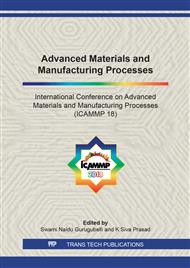[1]
Balasundar, M.S. Rao, T.Raghu Equal channel angular pressing die to extrude a variety of materials,, Materials & Design, Vol. 30, Issue 4, April 2009, 1050-1059.
DOI: 10.1016/j.matdes.2008.06.057
Google Scholar
[2]
M.S. Ghazani, A. Vajd, B.Mosadeg 3D finite element study of temperature variations during equal channel angular pressing, Journal of Advanced Materials and Processing, Volume 2, Issue 1, Winter 2014, 47-54.
Google Scholar
[3]
A. Rosochowski, L. Olejnik Finite element analysis of two-turn Incremental ECAP,, International Journal of Material Forming, April 2008, Volume 1, Supplement 1, 483-486.
DOI: 10.1007/s12289-008-0108-y
Google Scholar
[4]
C.Huvier, E. Conforto, H.E. Alami, D. Delafosse, and X. Feaugas. IOP Conf. Series: Materials Science and Engineering., (2009), 1-6.
DOI: 10.1088/1757-899x/3/1/012012
Google Scholar
[5]
Muralidhar, Avvari, S. Narendranath, H.Shivananda Nayaka. Effect to equal channel angular pressing on AZ31 wrought magnesium alloys,. Journal of magnesium and alloys1, no. 4(2013): 336-340.
DOI: 10.1016/j.jma.2013.11.007
Google Scholar
[6]
G. Raab, The innovation potential of ECAP techniques of severe plastic deformation, IOP Conference Series: Materials Science and Engineering, 63, 01 (2009).
DOI: 10.1088/1757-899x/63/1/012009
Google Scholar
[7]
KO Sanusi , OD Makinde , GJ Oliver. Equal channel angular pressing technique for the formation of ultrafine grained structures,. S Afr. J. Sci. (2012)108 (9/10), 212-217.
DOI: 10.4102/sajs.v108i9/10.212
Google Scholar
[8]
G.Faraji, F. Reshadi, and M. Baniasadia. A new approach for achieving excellent strain homogeneity in tubular channel angular pressing (TCAP) process., Journal of Advanced Materials and Processing 2, no. 1 (2014): 3-12.
Google Scholar
[9]
G. Faraji , M. M. Mashhadi A. F. Dizadji M. Hamdi A numerical and experimental study on tubular channel angular pressing (TCAP) process,, Journal of Mechanical Science and Technology, November 2012, Volume 26, Issue 11, 3463-3468.
DOI: 10.1007/s12206-012-0874-9
Google Scholar
[10]
G.Faraji, M.M. Mashhadi, S.H. Joo, H.S. Kim the role of friction in tubular channel angular pressing, Rev.Adv. Mater. Sci. 31 (2012) 12-18.
Google Scholar
[11]
M. Jahedi, M.H. Paydar Three-dimensional finite element analysis of torsion extrusion (TE) as an SPD process., Materials Science and Engineering: A 528, no. 29 (2011), 8742-8749.
DOI: 10.1016/j.msea.2011.08.055
Google Scholar
[12]
Figueiredo, B Roberto , Gustavo CV de Faria, P.R. Cetlin, and T.G. Langdon. Three-dimensional analysis of plastic flow during high-pressure torsion., Journal of Materials Science 48, no. 13 (2013), 4524-4532.
DOI: 10.1007/s10853-012-6979-9
Google Scholar
[13]
DJ Lee, EY Yoon, SH Lee, SY Rang finite element analysis for compression behavior of high pressure torsion processing, Rev. Adv. Mater. Sci. 31 (2012) 25-30.
Google Scholar
[14]
Todaka, Yoshikazu, Minoru Umemoto, Ayumi Yamazaki, Jun Sasaki and koichi Tsuchiya. Influence of high-pressure torsion straining conditions on microstructure evolution in commercial purity aluminum., Materials transactions 49, no. 1 (2008): 7-15.
DOI: 10.2320/matertrans.me200713
Google Scholar
[15]
D.C. Patil S.A. Kori , K.Venkateswarlu, G. Das , S.N. Alhajeri, T. G. Langdon Using ball indentation to determine the mechanical properties of an Al-7475 alloy processed by high-pressure torsion, Journal of Materials Science, July 2013, Volume 48, Issue 13, 4773-4779.
DOI: 10.1007/s10853-012-6969-y
Google Scholar
[16]
J Zhang, N Gao, MJ Starink Al-Mg-Cu based alloys and pure Al processed by high pressure torsion: The influence of alloying additions on strengthening, Materials Science and Engineering: A,Volume 527, Issue 15, 15 June 2010, 3472-3479.
DOI: 10.1016/j.msea.2010.02.016
Google Scholar
[17]
I. Balasundar , T. Raghu On the die design for Repetitive Upsetting - Extrusion (RUE) process, International Journal of Material Forming June 2013, Volume 6, Issue 2, 289-301.
DOI: 10.1007/s12289-011-1086-z
Google Scholar
[18]
T. Raghu, I. Balasundar, Severe Plastic Deformation (SPD) Using a Combination of Upsetting and Extrusion, Journal of Metallurgical Engineering (ME) Vol. 2 Issue 4, 2013, 130-139.
Google Scholar
[19]
Balasundar, I., K. R. Ravi, and T. Raghu. Strain softening in oxygen free high conductivity (OFHC) copper subjected to repetitive upsetting-extrusion (RUE) process., Materials Science and Engineering: A 583 (2013), 114-122.
DOI: 10.1016/j.msea.2013.06.029
Google Scholar
[20]
M.S. Ghazani, A,Vajd , Finite Element Analysis of the Groove Pressing of Aluminum Alloy,Modeling and Numerical Simulation of Material Science, (2014),4, 32-36.
DOI: 10.4236/mnsms.2014.41006
Google Scholar
[21]
N. SOLHJOEI, A. R.Varposhty , H. Mokhtarian , A. Manian a comparative study to evaluate the efficiency of rcs and cgp processes, Indian J. Sci.Res.l(2): 563-572, (2014).
Google Scholar
[22]
A Shirdel, A Khajeh, M M Moshksar, Experimental and finite element investigation of semi-constrained groove pressing process,, Materials & Design,Volume 31, Issue 2, February 2010, Pages 946-950.
DOI: 10.1016/j.matdes.2009.07.035
Google Scholar
[23]
N.Rangaraju, T.Raghuram, B.VamsiKrishna , K.PrasadRao ,P.Venugopal Effect of cryo-rolling and annealing on microstructure and properties of commercially pure aluminum, Materials Science and Engineering: A Volume 398, Issues 1-2, 25 May 2005, 246-251.
DOI: 10.1016/j.msea.2005.03.026
Google Scholar
[24]
P. Nageswara, R.D Singh. R Jayaganthan Mechanical properties and micro structural evolution of Al 6061 alloy processed by multidirectional forging at liquid nitrogen temperature, Materials & Design (1980-2015) Volume 56, April 2014, 97-104.
DOI: 10.1016/j.matdes.2013.10.045
Google Scholar
[25]
K Nakamural, K Neishil, K Kaneko, M Nakagaki, Z Horita Development of Severe Torsion Straining Process for Rapid Continuous Grain Refinement,, materials transactions, Vol. 45 (2004) No. 12 , 3338-3342.
DOI: 10.2320/matertrans.45.3338
Google Scholar


